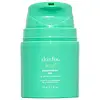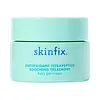What's inside
What's inside
 Key Ingredients
Key Ingredients

 Benefits
Benefits

 Concerns
Concerns

No concerns
 Ingredients Side-by-side
Ingredients Side-by-side

Water
Skin ConditioningCaprylic/Capric Triglyceride
MaskingPropanediol
SolventSqualane
EmollientSolanum Tuberosum Pulp Extract
SmoothingNiacinamide
SmoothingSodium Stearoyl Lactylate
EmulsifyingPisum Sativum Peptide
Skin ConditioningSodium Hyaluronate
HumectantFurcellaria Lumbricalis Extract
Skin ConditioningOleyl Adapalenate
Glycerin
HumectantLaminaria Digitata Extract
Skin ProtectingTocopherol
AntioxidantOpuntia Ficus-Indica Stem Extract
Skin ConditioningGalactoarabinan
Chlorophyllin-Copper Complex
AntioxidantMaltodextrin
AbsorbentSchizophyllan
HumectantPolylysine
Tripeptide-1
Skin ConditioningXanthan Gum
EmulsifyingSodium Citrate
BufferingMagnesium Stearate
Cosmetic ColorantEthylhexylglycerin
Skin ConditioningButylene Glycol
HumectantDextran
Citric Acid
BufferingPhenoxyethanol
PreservativeWater, Caprylic/Capric Triglyceride, Propanediol, Squalane, Solanum Tuberosum Pulp Extract, Niacinamide, Sodium Stearoyl Lactylate, Pisum Sativum Peptide, Sodium Hyaluronate, Furcellaria Lumbricalis Extract, Oleyl Adapalenate, Glycerin, Laminaria Digitata Extract, Tocopherol, Opuntia Ficus-Indica Stem Extract, Galactoarabinan, Chlorophyllin-Copper Complex, Maltodextrin, Schizophyllan, Polylysine, Tripeptide-1, Xanthan Gum, Sodium Citrate, Magnesium Stearate, Ethylhexylglycerin, Butylene Glycol, Dextran, Citric Acid, Phenoxyethanol
Water
Skin ConditioningGlycerin
HumectantTridecyl Neopentanoate
EmollientCetearyl Ethylhexanoate
EmollientOlus Oil
EmollientPropanediol
SolventGlyceryl Stearate Citrate
EmollientAmmonium Acryloyldimethyltaurate/Vp Copolymer
Vitis Vinifera Seed Oil
EmollientIsosorbide Disunflowerseedate
HumectantIsosorbide Dicaprylate
Skin ConditioningTetrapeptide-14
Skin ConditioningEchium Plantagineum Seed Oil
Skin ConditioningAspalathus Linearis Extract
Skin ConditioningHydrolyzed Hyaluronic Acid
HumectantMel Extract
MoisturisingBoswellia Serrata Extract
Skin ConditioningCeramide NP
Skin ConditioningPhytosphingosine
Skin ConditioningCeramide AP
Skin ConditioningCholesterol
EmollientCeramide EOP
Skin ConditioningColloidal Oatmeal
AbsorbentRosa Damascena Flower Water
MaskingCucumis Sativus Fruit Water
Skin ConditioningSimmondsia Chinensis Seed Wax
Skin ConditioningOlea Europaea Husk Oil
Skin ConditioningHelianthus Annuus Seed Oil
EmollientCamellia Sinensis Leaf Extract
AntimicrobialAloe Barbadensis Leaf Juice
Skin ConditioningTocopherol
AntioxidantTrisodium Ethylenediamine Disuccinate
Butylene Glycol
HumectantXanthan Gum
EmulsifyingEthylhexylglycerin
Skin ConditioningSodium Lauroyl Lactylate
EmulsifyingCarbomer
Emulsion StabilisingPhenoxyethanol
PreservativePotassium Sorbate
PreservativeSodium Benzoate
MaskingCitric Acid
BufferingCI 75810
Cosmetic ColorantWater, Glycerin, Tridecyl Neopentanoate, Cetearyl Ethylhexanoate, Olus Oil, Propanediol, Glyceryl Stearate Citrate, Ammonium Acryloyldimethyltaurate/Vp Copolymer, Vitis Vinifera Seed Oil, Isosorbide Disunflowerseedate, Isosorbide Dicaprylate, Tetrapeptide-14, Echium Plantagineum Seed Oil, Aspalathus Linearis Extract, Hydrolyzed Hyaluronic Acid, Mel Extract, Boswellia Serrata Extract, Ceramide NP, Phytosphingosine, Ceramide AP, Cholesterol, Ceramide EOP, Colloidal Oatmeal, Rosa Damascena Flower Water, Cucumis Sativus Fruit Water, Simmondsia Chinensis Seed Wax, Olea Europaea Husk Oil, Helianthus Annuus Seed Oil, Camellia Sinensis Leaf Extract, Aloe Barbadensis Leaf Juice, Tocopherol, Trisodium Ethylenediamine Disuccinate, Butylene Glycol, Xanthan Gum, Ethylhexylglycerin, Sodium Lauroyl Lactylate, Carbomer, Phenoxyethanol, Potassium Sorbate, Sodium Benzoate, Citric Acid, CI 75810
Ingredients Explained
These ingredients are found in both products.
Ingredients higher up in an ingredient list are typically present in a larger amount.
Butylene Glycol (or BG) is used within cosmetic products for a few different reasons:
Overall, Butylene Glycol is a safe and well-rounded ingredient that works well with other ingredients.
Though this ingredient works well with most skin types, some people with sensitive skin may experience a reaction such as allergic rashes, closed comedones, or itchiness.
Learn more about Butylene GlycolCitric Acid is an alpha hydroxy acid (AHA) naturally found in citrus fruits like oranges, lemons, and limes.
Like other AHAs, citric acid can exfoliate skin by breaking down the bonds that hold dead skin cells together. This helps reveal smoother and brighter skin underneath.
However, this exfoliating effect only happens at high concentrations (20%) which can be hard to find in cosmetic products.
Due to this, citric acid is usually included in small amounts as a pH adjuster. This helps keep products slightly more acidic and compatible with skin's natural pH.
In skincare formulas, citric acid can:
While it can provide some skin benefits, research shows lactic acid and glycolic acid are generally more effective and less irritating exfoliants.
Most citric acid used in skincare today is made by fermenting sugars (usually from molasses). This synthetic version is identical to the natural citrus form but easier to stabilize and use in formulations.
Read more about some other popular AHA's here:
Learn more about Citric AcidEthylhexylglycerin (we can't pronounce this either) is commonly used as a preservative and skin softener. It is derived from glyceryl.
You might see Ethylhexylglycerin often paired with other preservatives such as phenoxyethanol. Ethylhexylglycerin has been found to increase the effectiveness of these other preservatives.
Glycerin is already naturally found in your skin. It helps moisturize and protect your skin.
A study from 2016 found glycerin to be more effective as a humectant than AHAs and hyaluronic acid.
As a humectant, it helps the skin stay hydrated by pulling moisture to your skin. The low molecular weight of glycerin allows it to pull moisture into the deeper layers of your skin.
Hydrated skin improves your skin barrier; Your skin barrier helps protect against irritants and bacteria.
Glycerin has also been found to have antimicrobial and antiviral properties. Due to these properties, glycerin is often used in wound and burn treatments.
In cosmetics, glycerin is usually derived from plants such as soybean or palm. However, it can also be sourced from animals, such as tallow or animal fat.
This ingredient is organic, colorless, odorless, and non-toxic.
Glycerin is the name for this ingredient in American English. British English uses Glycerol/Glycerine.
Learn more about GlycerinPhenoxyethanol is a preservative that has germicide, antimicrobial, and aromatic properties. Studies show that phenoxyethanol can prevent microbial growth. By itself, it has a scent that is similar to that of a rose.
It's often used in formulations along with Caprylyl Glycol to preserve the shelf life of products.
Propanediol is an all-star ingredient. It softens, hydrates, and smooths the skin.
It’s often used to:
Propanediol is not likely to cause sensitivity and considered safe to use. It is derived from corn or petroleum with a clear color and no scent.
Learn more about PropanediolTocopherol (also known as Vitamin E) is a common antioxidant used to help protect the skin from free-radicals and strengthen the skin barrier. It's also fat soluble - this means our skin is great at absorbing it.
Vitamin E also helps keep your natural skin lipids healthy. Your lipid skin barrier naturally consists of lipids, ceramides, and fatty acids. Vitamin E offers extra protection for your skin’s lipid barrier, keeping your skin healthy and nourished.
Another benefit is a bit of UV protection. Vitamin E helps reduce the damage caused by UVB rays. (It should not replace your sunscreen). Combining it with Vitamin C can decrease sunburned cells and hyperpigmentation after UV exposure.
You might have noticed Vitamin E + C often paired together. This is because it is great at stabilizing Vitamin C. Using the two together helps increase the effectiveness of both ingredients.
There are often claims that Vitamin E can reduce/prevent scarring, but these claims haven't been confirmed by scientific research.
Learn more about TocopherolWater. It's the most common cosmetic ingredient of all. You'll usually see it at the top of ingredient lists, meaning that it makes up the largest part of the product.
So why is it so popular? Water most often acts as a solvent - this means that it helps dissolve other ingredients into the formulation.
You'll also recognize water as that liquid we all need to stay alive. If you see this, drink a glass of water. Stay hydrated!
Learn more about WaterXanthan gum is used as a stabilizer and thickener within cosmetic products. It helps give products a sticky, thick feeling - preventing them from being too runny.
On the technical side of things, xanthan gum is a polysaccharide - a combination consisting of multiple sugar molecules bonded together.
Xanthan gum is a pretty common and great ingredient. It is a natural, non-toxic, non-irritating ingredient that is also commonly used in food products.
Learn more about Xanthan Gum